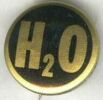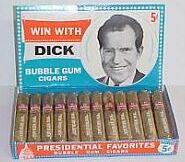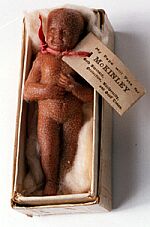
  |
 Not just because politicians are strange, or downright ugly in Nixon's case, but because not all the details transfer with time. Not just because politicians are strange, or downright ugly in Nixon's case, but because not all the details transfer with time. Culture, pop culture especially, is a funny thing that way. Political slogans & emblems are often mysterious or strange years later because the reasons for the symbol or even the political issue itself is no longer 'important,' perhaps it is even no longer remembered. Looking at them now, you learn a lot about American history. Ok, sometimes you laugh too, either at the symbols or the issues, or the freakin' candidates themselves. But personally, looking at political collectibles is rarely boring.
Starting around 1894, the pail symbolized the party's commitment to protecting American industry and labor by supporting a tariff on imports & to advocate full employment. It was first used on the all-important political campaign buttons (or pin backs) in the 1900 campaign, with over 15 different versions. It was so popular with the Republicans that this pail symbol was used until the Depression.
  Pins & buttons have always been popular. Did you know that the chemical symbols for gold &/or water, were displayed on items supporting Barry Goldwater for president in 1964? "Willkie Says Spinach is Spinach—It Sure Is, Franklin." This button was derived from a New Yorker cartoon, in which a kid tries some broccoli, then pushes her plate away with the words "I say it's spinach and to hell with it." The button's message is that Willkie would 'tell it like it is.' But political campaigns have used more than the traditional buttons to promote candidates & issues. Ceramics, glass, bandannas, canes, hats, jewelry, lampshades & even pipes have been used to carry the message, the face & the slogans of candidates & parties. Where-ever there has been a symbol available to rally the public, it has been used as well.
The 'odd' orange octopus covering this milk-glass silver-dollar flask is an example of such symbolism, and while it may not be the same message used with today's symbolism of the octopus, it is still valued by collectors today -- In fact this flask, dating to 1901, sold for $1,000 at a Glass Works Auction in East Greenville, Pa. But this is a newsletter dedicated to 'kitsch,' so I suppose many may consider the pretty historical milk glass flask to 'nice' to be here... So let's move along to the 'tacky,' shall we? And in my opinion, what can be tackier than Nixon?
It is interesting to note that the candy bar, like the President, is no longer... I imagine more folks miss the candy bar.
Cigars have been a powerful political symbol through the years. *Struggling to refrain from any Clinton comments* Perhaps the oddest political collectible that I could find was this century-old "soap baby." This baby wears a tag that says "My Papa will vote for McKinley," but there were those endorsing Bryan as well. (And Bryan ones are much rarer now than ones promoting McKinley.)
McKinley items are very popular to collectors as this was one of the first 'modern' political campaigns -- the amount of advertising material put out (by both candidates) was huge. Even if you are not a person who values the cultural or historical value of political collectibles, or, dare I think it, you lack the ability to value the hysterical in many of these items, keep your eyes out for unusual political pieces -- They sell for high prices! A box of Nixon bubblegum cigars? They sell for between $40 & $95. The soap babies, while maybe fetching auction prices of $15 to $30 (for McKinley anyway), are given replacement vales of $75 by insurance companies - indicating they will only rise in value. The dinner pail pin above, in nice conditions, sells for well over $100 (and that was in 1997!) Who knows what the 2004 campaign bumper stickers, pins, sweatshirts, comics, etc. will fetch at the auctions of decades from now? So while you search flea markets for the old campaign trail items, pack away a few 'classics' from this year too... It seems it might be safer to invest in the collectible items of politicians than the politicians themselves.
|


 For example, did you know that the Republicans have used other symbols besides the elephant? Did you know one of them was a dinner pail?!
For example, did you know that the Republicans have used other symbols besides the elephant? Did you know one of them was a dinner pail?!  In 1901, the political news was about the
In 1901, the political news was about the  "Yes Nixon, No Jelly," a tab from a candy company to promote their 'Peanut Butter No Jelly' candy bar during the campaign. (Yes, there was a matching McGovern one too, but I like mocking Nixon - & I have quite the Anti-Nixon collection to prove it! *neener neener*)
"Yes Nixon, No Jelly," a tab from a candy company to promote their 'Peanut Butter No Jelly' candy bar during the campaign. (Yes, there was a matching McGovern one too, but I like mocking Nixon - & I have quite the Anti-Nixon collection to prove it! *neener neener*)  Speaking of Sticky-Tricky-Dicky... How about these “Win With Dick” Bubble Gum Cigars?!
Speaking of Sticky-Tricky-Dicky... How about these “Win With Dick” Bubble Gum Cigars?!  The soap baby was used in the election of 1896, aka Republican William McKinley vs. Democrat William Jennings Bryan.
The soap baby was used in the election of 1896, aka Republican William McKinley vs. Democrat William Jennings Bryan.